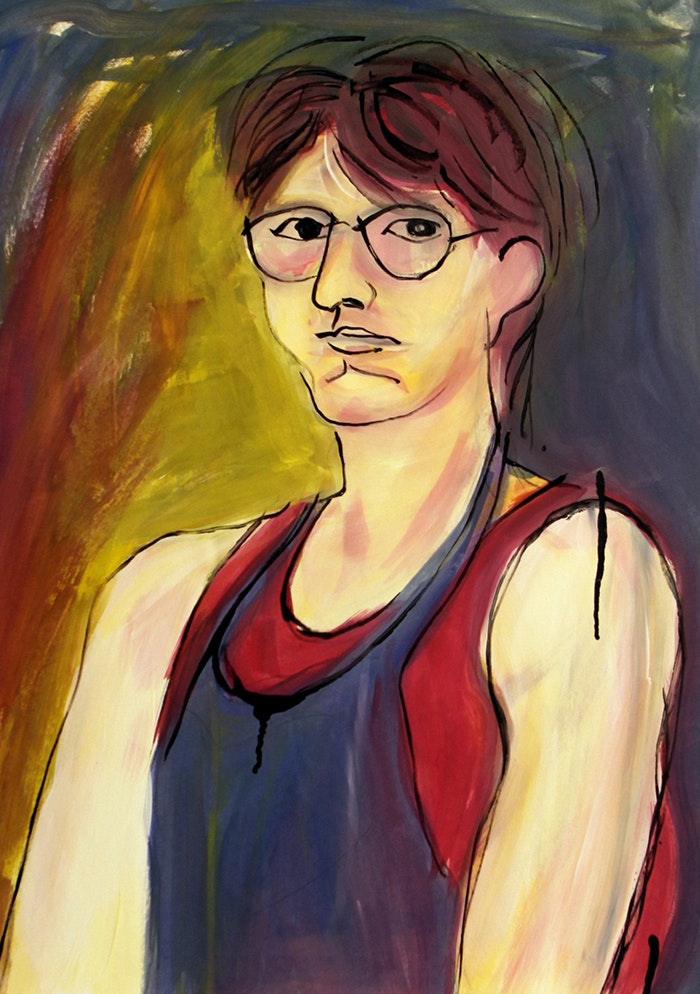Seller Story
Carol J. Mathews, Cincinnati, OH
“I have found that Carol Mathews’ story brings her art to life. My objective with sharing her art is to help people view Carol’s art through Carol’s mind and experience her reality – the world of mental illness. I learned so much from going through this art that I wish I had known while she was alive. I’m glad we get to share her story.
My sister Carol was a very kind and shy person, even from childhood. All seven of us siblings have an artistic bent, but Carol was the most diverse in her talent out of all of us – she has everything from abstracts and charcoals to figure drawings in her body of work. The depth of her talent is astounding. She worked out of her converted garage studio and used her art to express her mind. She had written, ‘I can’t tell people in words of my experience, but I can draw it.’ Carol’s art was her therapy, but also her work.
Born and raised in Evansville, Indiana, Carol began to exhibit symptoms of mental illness after her freshman year of college. She was diagnosed with schizoaffective disorder shortly thereafter. Most of us don’t know much about this illness, so we tend to be afraid of it. I am on a mission to make this something we can talk about openly, comfortably and without stigma, just as if I were going to ask you how you were doing with your diabetes or your heart condition.
During the last few years of Carol’s life, her symptoms grew more severe, and I began calling her a few times a week on Sunday, Tuesday, and Thursday. Sometimes the calls lasted five minutes, sometimes an hour. After her death, I went through about 600 of her sketchbook journals. I discovered that even on her good days, she was still battling this illness. Perhaps that is why, during our grieving, my siblings and I unanimously felt she was finally at peace.” – Robin Cox


Carol J. Mathews Oil Painting of an Abstract Face

Carol J. Mathews Original Abstract Oil Painting on Canvas

Carol J. Mathews Original Abstract Oil Painting on Canvas of the Number "3"

Carol J. Mathews Original Abstract Oil Painting on Pressed Board

Carol J. Mathews Original Oil Painting on Canvas of the Number "4"

Carol J. Mathews Oil Painting "Can't Concentrate"

Carol J. Mathews Pair of Abstract Watercolor Paintings

Carol J. Mathews Orginal Abstracr Oil Painting on Canvas


Carol J. Mathews Orignal Oil Painting on Canvas "Fish Tank"

Carol J. Mathews Original Abstract Oil Painting on Canvas of the Number "5"

Carol J. Mathews Original Oil Painting on Canvas "Landscape"

Carol J. Mathews Original Abstract Oil Painting on Canvas of the Number "4"

Carol J. Mathews Pair of Abstract Gouache Paintings

Carol J. Mathews Mixed Media Painting

Carol J. Mathews Set of Abstract Watercolors

Carol J. Mathews Original Abstract Oil Painting on Canvas of the Number "6"

Carol J. Mathews Oil Painting on Board "Self Portrait"

Carol J. Mathews Abstract Mixed Media Painting

Carol J. Mathews "Number Series" Drawing

Carol J. Mathews Abstract Watercolor Painting

Carol J. Mathews Abstract Watercolor Painting

Carol J. Mathews Watercolor Painting of an Abstracted Bird

Carol J. Mathews Original Oil Painting on Canvas "Uterus"

Carol J. Mathews Collection of Journal Pages

Carol J. Mathews Geometric Abstract Painting

Carol J. Mathews Geometric Abstract Oil Painting

Carol J. Mathews Original Abstract Oil Painting on Canvas

Carol J. Mathews Orignal Abstract Oil Painting on Paper

Carol J. Mathews Black and White Abstract Drawing

Carol J. Mathews Oil Painting on Board "Art is Dirty"

Carol J. Mathews Original Oil on Canvas Portrait Painting

Carol J. Mathews Original Abstract Watercolor Painting

What is the most impactful work of art you’ve come across from exploring her journals and manuscripts?
Her handwritten artist statement. She begins it with, “I am a schizophrenic artist. I have survived suicide 3 times. After those failures, I decided to surrender to the fact that I was meant to be an artist.”
What have you learned from your conversations with Carol near the end of her life?
Carol and I talked on the phone two or three times a week, and in the beginning, I would try to talk her out of the paranoia she experienced and attempt to bring her back into what I considered sanity. I realize in hindsight how counterproductive that was, as that was not respecting her reality.
What’s something everyone can practice when confronting someone afflicted with mental illness?
It’s so important that the ill person feels comfortable. Most mentally ill people are embarrassed of their disorder. As the well person, what I’ve learned is that I can “change my language.” It’s a small and easy shift that makes a big difference. For example, I wouldn’t say, “She is schizophrenic,” because she is not her illness. The same way you wouldn’t say, “She is cancer.”
Has Carol better equipped you for this mission?
Absolutely. It’s such a difficult medical field to navigate for an ill person – nearly impossible for a well person. Her art has inspired and motivated me to incite a conversation and change the way we approach mental illness.







